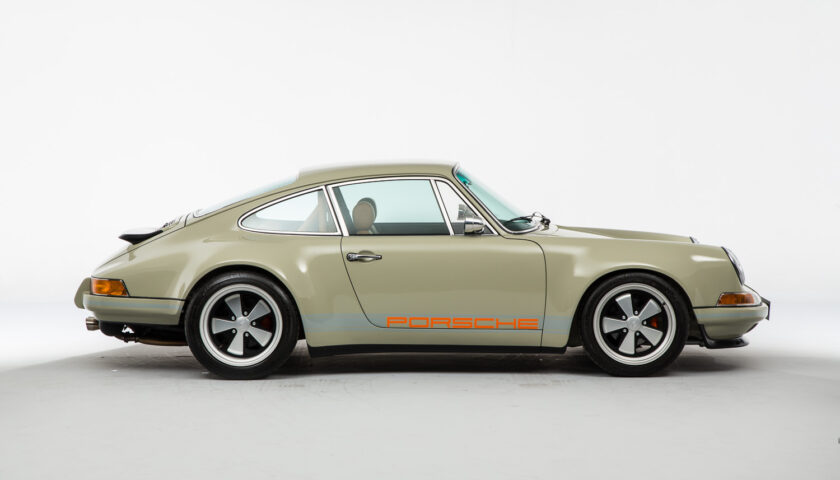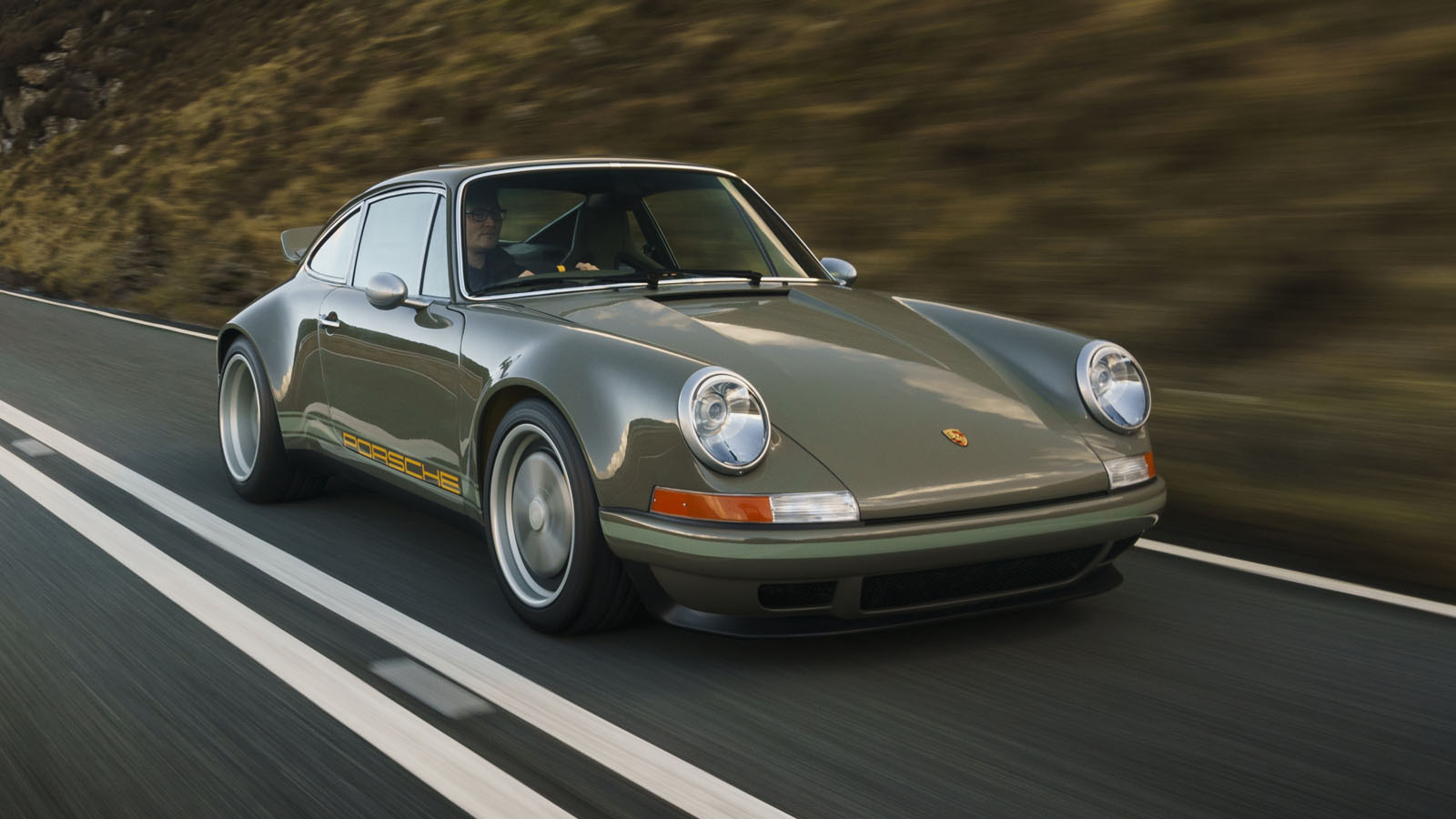To find out what makes this nearly $600,000 restomod by Theon Design tick, we took it for a spin.
Do you want to know what sets Theon Design’s restomod Porsche 911s apart from the rest? A/C frunk door open.
I know, the trunk is an odd place to begin when talking about a £500,000 (roughly $600,000) Porsche whose unusual supercharged flat-six is the most obvious talking point. If you want to know how much work goes into making one of these radically re-made 964-generation 911s, all you have to do is open the trunk and take a look at the embossed leather panels and leather-wrapped RS strut-brace.
Just imagine how much work has gone into making the crucial parts function if UK-based Theon goes to such lengths to make the luggage bay look good, and to do other stuff that you’ll never even get to see unless you’re the guy who put it together in Theon’s workshop.

The reshaped fenders, available in steel (as seen here) or carbon depending on taste and budget, and the carbon bumpers and spoiler standard on every unit help reduce curb weight to 1,265 kg (2,789 lbs) from the 1,350 kg (2,976 lbs) of the standard 964 Carrera 2 donor. Or the way the suspension is configured; the 964 was the first Porsche to feature adjustable dampers with five different settings, giving drivers a degree of control over the car’s ride and handling that wasn’t seen in the 911 until 25 years after the 964’s debut in 1989.
Or the turbocharged motive force that drew you in. Although turbocharging has been standard on 911s for nearly half a century, the Belgian client who ordered BEL001 requested a supercharger. Perhaps an unusual request, but consistent with his goal of creating a 911 that evoked more of a GT spirit than the high-revving, naturally aspirated Porsches Theon had previously built for clients.
More muscle than a 964 Turbo S
Thus, the fully rebuilt motor now has a compact Rotrex supercharger in the place of the air conditioning unit, in addition to independent throttle bodies, flowed and ported heads, tough Carillo rods, custom cams, and motorsport-grade pistons. Instead of cutting air intakes into the body, twin charge coolers and water methanol injection were used to increase fuel octane, and the resulting 400 horsepower (406 PS) and 367 lb-ft (498 Nm) are sent to the rear wheels via the standard five-speed manual transmission.
The Theon’s creative director and former designer for BMW, Jaguar, and Lexus, Adam Hawley, has assured me that a six-speed transmission is feasible, and that the shorter, closer ratios increase the vehicle’s “kick in the back.” However, it’s cool to let the car stretch out and wind its way through the rev range in the taller cogs because of the engine’s torque. It’s got the muscle to let you do that, thanks to the 52 lb-ft (71 Nm) of torque that’s available from low in the rev range and the fact that this supercharged motor produces the same amount of power as Theon’s top-spec 4.0 naturally aspirated engine (milder 3.6 and 3.8s can also be ordered).

When you’re tearing up through second and third gear, or when you crack the right pedal wide open in fourth to let all that torque hurl the car forward, there is no audible whine or noticeable change in performance to signpost the artificial aspiration. As the active exhaust is turned up to its loudest setting, the car still manages to exude the effortless swiftness and abundant power of a freshly blown engine. Keep in mind that you’re not in a track day weapon, but a GT. However, when the accelerator is released, the supercharger makes some chirping noises that the owner adores but I could do without. Once the novelty wore off, I imagine they’d become annoying, but you might disagree.
Built for real roads
However, I would not change anything about the chassis. Super-rigid racecars have trouble handling the UK’s nasty roads, which are potholed and have a noticeable crown in the center, so they’re usually better suited for the track. However, thanks to the owner’s forthrightness about how, where, and when he would use BEL001, as well as Theon’s interpretation of that remit, the vehicle performs superbly on the road.
The ride quality is superior to that of many contemporary cars and crossovers, the steering feel is more satisfying than that of most contemporary supercars, and body roll is restrained even with the optional TracTive dampers set to their softest setting. Before you’ve even gotten out of first gear and experienced the silky smooth shift, you’ll feel at home behind the wheel of this vehicle.
By maintaining a flexible chassis, the tires will spend more time in contact with the rough pavement, allowing you to confidently floor the gas pedal in the rain without having to look out the side window. When you’re putting your right foot down on a car that cost somebody half a million pounds, having the man who designed and owns the company sitting next to you can give you peace of mind.

Seats in BEL001 are not as obviously sporty as those in the earlier CHI001, which was designed with less of a GT character in mind, but they are still comfortable and provide ample support for both daily driving and the occasional trackday. Overall, the car’s cabin doesn’t quite have the same “wow” factor as, say, a Singer Classic (you didn’t think I’d review a car without mentioning the S-word, did you?). just on the surface, but that’s partly because the owner went for a low-key GT-style trim with plain leather facings, and partly because Theon’s finish is almost too polished to be believable.
You see, just like the trunk, the interior is crafted so beautifully that, unless you’re a bit of a 964 geek, you might assume that all the clever bits, the door panels, the lower console, the switchgear, and the rear tunnel trim, are OEM. Everything fits with Hawley’s claim that he isn’t making any radical changes to the 911 but rather improving upon its existing features. The magnetic phone holder on the dashboard, which can be placed in the space normally occupied by the radio, is a neat addition.
The few issues we had were mostly due to the donor vehicle, such as the off-center driving position, or were easily rectifiable, such as the steering column needing more reach or the electric seat adjustment procedure being like trying to get your front door key in the lock at 3 in the morning after a dozen beers.
In fact, that’s the beauty of transformations like these. Due to the low volume of production, the company is able to make changes and improvements with each vehicle. They also appear to enjoy the challenge of responding to specific requests from commissioning customers, such as the inclusion of a supercharger in this vehicle.
It’ll End Up Costing You Over Half A Million
Seeing as how Theon’s commissions begin at £380,000 ($457,000) plus local taxes and the cost of a donor car, and the example we’re driving probably cost 30 percent more, this is to be expected. It’s debatable whether it’s worthwhile to spend £500,000 (roughly $600,000) customizing a base 964 Carrera 2 when you can buy a genuine 964 RS for half the price, but there’s no doubt that Theon pours his heart and soul into the 18-month-long builds.
However, people with this kind of disposable income often aren’t choosing between cars, as they have enough cash to buy a machine like the Theon, as well as a 964 RS and half a dozen other cars we’d give our right arm to own.

Theon hopes to produce around 30 964 conversions before moving on to its next program, the nature of which is also likely to involve Porsche. I highly doubt I’ll ever be in a position to commission my own Theon build, but after this experience, I can’t help but imagine what specifications I’d want for my own. How would you envision it?
Read More – The 2025 Toyota Camry: Potentially the Next Best-Selling Sedan in the U.S.





